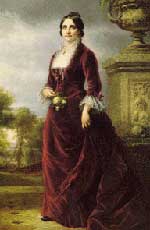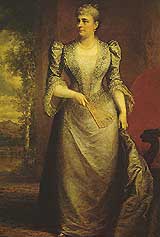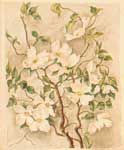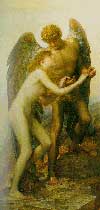- African-American History Month
- Presidents & Baseball
- Grounds and Garden
- Easter Egg Roll
- Christmas & Holidays
- State of the Union
|
Home >
History & Tours >
Art in the White House: A Nation's Pride
|
Art for the President's House —
An Historic Perspective
by Doreen Bolger & David Park Curry
 A work that captured the pathos of this historic event was William Tolman
Carleton's Watch Meeting--Dec. 31st 1862--Waiting for the Hour (at
right), which depicted slaves eagerly anticipating the moment when the
proclamation would take effect. The version of this painting presented
to Lincoln by William Lloyd Garrison on behalf of a group of
abolitionists left the Executive Mansion after the President's
assassination. An earlier version of the same painting by Carleton was
acquired more than a century later. Moreover, no portraits of Lincoln
were secured for the collection until after his death, perhaps because
his contemporaries found that available portraits inadequately
represented his actual appearance and character. The poet Walt Whitman,
for one, complained:
A work that captured the pathos of this historic event was William Tolman
Carleton's Watch Meeting--Dec. 31st 1862--Waiting for the Hour (at
right), which depicted slaves eagerly anticipating the moment when the
proclamation would take effect. The version of this painting presented
to Lincoln by William Lloyd Garrison on behalf of a group of
abolitionists left the Executive Mansion after the President's
assassination. An earlier version of the same painting by Carleton was
acquired more than a century later. Moreover, no portraits of Lincoln
were secured for the collection until after his death, perhaps because
his contemporaries found that available portraits inadequately
represented his actual appearance and character. The poet Walt Whitman,
for one, complained:
None of the artists or pictures have caught the deep, though subtle and indirect expression of this man's fact. There is something else there. One of the great portrait painters of two or three centuries ago is needed.
The trauma of civil warfare shook America's growing confidence as an international power, and a pervasive spirit of historicism governed the collecting and decorating instincts of the next three Presidents: Andrew Johnson, Ulysses S. Grant, and Rutherford B. Hayes. When Johnson moved into the White House during the summer of 1865, the expensive plushes and brocatelles Mary Lincoln had chosen were already shabby. Upon Lincoln's death, ruthless collectors in search of souvenirs had carried off silverware and china, and had vandalized furniture, drapes, and carpets. Johnson's daughter Martha Patterson refurbished the Blue Room, continuing the tendency toward fashion-conscious turnover in White House decor. She placed rococo revival furniture from the prewar Buchanan Administration against blue wallpaper relieved by panels bordered in black and gold. It was she who discovered in the attic the series of presidential portraits that Healy had painted before the Civil War. She showed them to her delighted father, who secured an appropriation for framing them. In 1867 they were hung in the transverse hallway on the State Floor, where Johnson enjoyed discussing the accomplishments of his predecessors with his guests.
During Johnson's term the seed was planted for the First Lady portrait collection. Julia Gardner Tyler proposed to Johnson the idea of a portrait collection of the wives of Presidents (the term "First Lady" had not yet come into popular use). To that end, she donated a portrait of herself, painted by Francesco Anelli in 1848, three years after she had left the White House.
With the subsequent Grant Administration came a return to lavish entertainment and an ebullient redecoration of the Executive Mansion. Enormous crystal chandeliers were hung in the East Room, and golden ornaments embellished a White House dressed up for the Gilded Age. The Entrance Hall celebrated the achievements of the Republican Party, with a color scheme of red, white, and blue carried out in flag, shield, and eagle motifs. Two oval paintings representing the allegorical figures Liberty and Union, by Constantino Brumidi, were installed as ceiling decorations. During the Grant Administration the White House was first considered historical by visitors to the capital city. By calling at the north door, weekdays from ten to three, visitors could view presidential portraits beginning with Stuart's Washington and ending with William F. Cogswell's posthumous portrait of Lincoln, selected by Grant in 1869.
By 1876, the nation's centennial year, public fascination with American history was growing and a colonial revival was in full swing. The events, people, and artistic heritage of the past century assumed a revitalized place in the present. United States history was now considered especially worthy of study; American artifacts were deemed suitable for collection and imitation. Symbolically as well as stylistically, colonial and early federal motifs were adopted and adapted by both painters and designers.

This passion for the past affected the residents of the Executive Mansion. "I love this house for the associations that no other could have," exulted First Lady Lucy Hayes in 1878, the year she acquired Martha Washington's portrait. Eager to commemorate the house's occupants, Mrs. Hayes consulted A.R. Spofford, the Librarian of Congress, and decided to complete the historical collection of presidential portraits begun by Healy before the Civil War. The very selection of a librarian as an art adviser underscores Mrs. Hayes' desire to pursue documentation rather than art. Spofford's attempts to acquire Stuart portraits of John Adams and Thomas Jefferson from their families failed, so he soon embarked on a predictable course, commissioning copies to fill the void left by the unavailability of original life portraits. He first secured the services of the Boston painter Edgar Parker, an accomplished copyist of Gilbert Stuart, to replicate portraits of Adams, Madison, and Monroe.
President and Mrs. Hayes, whose impatience to complete the series was known, were approached by Eliphalet Frazer Andrews, the painter of Martha Washington's portrait and of an earlier portrait of President Hayes. Andrews wanted to produce impressive canvases suited to the scale of the East Room. He undertook full-length posthumous portraits--including images of Jefferson and Jackson--based on careful research. And he carried the replication process to further extremes by using earlier portraits by other artists and even photographs as models to make not one copy but multiple images of individual sitters. Less appealing to 20th-century eyes than the originals, such copies must be viewed in the spirit that motivated their creation. At that time works were added to the White House collection because of the eminence of their sitters, not the eminence of their creators. That copies could satisfy was the result of a once commonplace feature of artistic education. Painters routinely learned to paint by copying the work of established artists. Imitation was encouraged until a would-be painter demonstrated mastery over the essentials of his technique.
Mrs. Hayes did not select Andrews to paint her own image, however. When the National Women's Christian Temperance Union (WCTU) offered to fund a suitable memorial to her, she settled on a portrait and made a more artistic choice of painters. He was Daniel Huntington, then president of the National Academy of Design and one of the most fashionable portraitists of his generation. The likeness, presented to the White House in 1881, was hung just as the Hayes Administration ended. After President Hayes left the White House he followed his wife's example, selecting Huntington to execute a companion piece. Mrs. Hayes was the first presidential wife to have her portrait painted for the White House collection, and the Hayeses' portraits are the first pair--President and First Lady--to enter the collection in reasonable proximity. It is not mere chance that their large-scale and grand manner poses beg for comparison with the more memorable Stuart Washington and its belated companion by Andrews. The Hayeses' slightly grandiose portraits, as well as their White House memorabilia and copious scrapbooks of clippings, suggest that this presidential couple sought for themselves the same exalted place in White House history that they had helped secure for George and Martha Washington.
Mrs. Hayes, who along with her husband had agreed to ban liquor at the White House, was widely admired, even hailed as representing "the new woman era." The First Lady and her contemporaries, including the WCTU donors of her portrait, seem to have endorsed the tradition begun by Julia Tyler of building a portrait collection.
During the eight years between the Hayes Administration and that of Benjamin Harrison, the collection changed little beyond the addition of presidential portraits. This was partially the result of circumstance. Shot by an assassin, James A. Garfield died in September 1881, only months after taking office. His successor, Chester A. Arthur, was preoccupied with a major redecoration of the White House. And Grover Cleveland so openly disliked the lack of privacy at the White House that he used it primarily for official functions, preferring to live in his nearby summer retreat.
For the fine arts collection an important trend of the 1880s and 1890s was a pronounced interest in highly fashionable decoration. The occupants of the President's House were not immune to the American Aesthetic movement, which had begun to stir under British inspiration during the mid-1870s. It introduced art principles into the production of furniture and other decorative objects; fostered collaboration among architects, painters, and craftsmen; and placed heavy emphasis on the artistic unity of the interior. Each piece, even a painting or a sculpture, was integrated into a visually complex whole. While this reform movement sought to overturn generations of borrowing from previous styles (neoclassical, rococo, and Renaissance revivals had followed in rapid succession), it also imaginatively reinterpreted the past, finding a special stimulus in Oriental art.
Greater interest in the artful interior was eventually to have impact on the White House collection, as aesthetics began to play a larger role. Choices of paintings and sculpture made on the basis of historicism were tempered as "art for art's sake" gained widespread popularity. Albert Bierstadt, in general an unsuccessful promoter of his own work for the collection, had created several aesthetic tokens, colorful butterflies, in the White House for the Hayes family. Bierstadt would apply oil paints directly to the paper to form one wing of a butterfly, then fold the paper to produce a mirror image and complete the shape. A departure from the portraiture that then dominated the collection, the butterflies symbolize the decorative-interior priorities of the Aesthetic movement. The occupants of the White House would test their aesthetic sensibilities on interior decoration, however, long before they addressed the more complex activity of collecting American painting and sculpture as works of art rather than as historical documents.
Excursions into high-fashion decor stimulated a new art consciousness. The first pieces to be gathered for the White House with an aesthetic eye were decorative objects. Their accumulation eventually changed attitudes toward both the collecting and display of painting and sculpture. As early as 1860 a Japanese delegation had visited the United States capital, presenting the White House with state gifts that included a handsome lacquered cabinet ornamented with abstract embellishments. Two decades later, when Louis Comfort Tiffany and his decorative firm, Associated Artists, undertook a renovation of the White House, they were inspired by motifs from Japan.
This up-to-the-minute aesthetic redecoration of the house was commissioned in 1882 by President Arthur, a sophisticated New Yorker who was himself familiar with the extravagant domestic interiors then being fashioned for merchant princes and captains of industry. The Blue Room ceiling was covered with a shield-and-star pattern, while hand-pressed wallpaper twinkled with colored glass. The mansion's stately transverse hall (today known as the Cross Hall), articulated by the original marble columns, was interrupted for the moment by a sparkling colored glass screen designed by Louis Tiffany and described in this way for the readers of Century Magazine:
The light coming through the partition of wrinkled stained-glass mosaic makes a marvelously rich and gorgeous effect, falling upon the gilded niches where stand dwarf palmetto trees, the silvery net-work of the ceiling, and the sumptuous furniture. Indeed, the only dark tints in the apartment are found in the portraits, which become the more conspicuous by reason of their contrast with their brilliant setting.
The enthusiastic reporter concluded that Tiffany's changes had
"metamorphosed" the President's House, which had until that time
displayed a "hotel character."
The journalist's comment about portraits--"more conspicuous by reason of their contrast with their brilliant setting"--is a telling one, for it indicates that in artistic matters presidential taste was still governed by long-established tradition. Arthur's official portrait, predictably by the fashionable Huntington, was dark and dignified, painted in the conservative grand manner format already established by the patronage of the stodgier Hayeses. The Aesthetic movement celebrated the value of art in the home. Women collected bric-a-brac avidly, transformed their houses with new decorative schemes, and increasingly became amateur or professional artists and artisans. Decorative arts, such as wood carving, china painting, and needlework, became important creative outlets for talented women seeking socially acceptable occupation and employment.
The artistic pursuits of several First Ladies typify the often feminine orientation of the movement. Mrs. Hayes had commissioned the creation of an elaborate set of presidential china, designed by the artist Theodore Davis. Rather than displaying the usual emblematic eagle, more than 400 pieces of Haviland china realistically captured American flora and fauna. A century later a concentrated interest in American themes such as those depicted on the china would drive the White House's collecting of painting and sculpture.

 In the early 1890s
Caroline Harrison, wife
of President Benjamin
Harrison, conducted a series of china-painting classes in the White House
conservatory. One of her paintings, Flowering Dogwood, appears at the
right. An amateur artist, she decorated china blanks with floral motifs similar
to those she executed on paper. Interest in portraits of First Ladies now
increased as women began to play a more public role in the arts and in American
culture.
In the early 1890s
Caroline Harrison, wife
of President Benjamin
Harrison, conducted a series of china-painting classes in the White House
conservatory. One of her paintings, Flowering Dogwood, appears at the
right. An amateur artist, she decorated china blanks with floral motifs similar
to those she executed on paper. Interest in portraits of First Ladies now
increased as women began to play a more public role in the arts and in American
culture.
Caroline Harrison established the collection of historic china
associated with the White House and supported the addition of paintings to the
fine arts collection. Besides a portrait of her husband's predecessor,
Grover Cleveland, by the
distinguished artist Eastman Johnson, significant additions included Mrs.
Harrison's image by Daniel Huntington and two Van Buren-related works
bequeathed by a descendant of that President.
 Yet contemporary art was
neglected. Albert Bierstadt had lent oils of the American West to the White
House in the hope that Congress would purchase them. The legislators
disappointed the artist, purchasing instead in 1890 a modest watercolor by
James Henry Moser. Virtually forgotten now, Moser had taught watercolor
painting to Mrs. Harrison. The Moser, a less-than-impressive substitute for one
of the Bierstadts, somewhat timidly serves as the first example of a
nonportrait purchase by the United States government for the White House. A
Bierstadt work (at right) was later added to the White House collection.
Yet contemporary art was
neglected. Albert Bierstadt had lent oils of the American West to the White
House in the hope that Congress would purchase them. The legislators
disappointed the artist, purchasing instead in 1890 a modest watercolor by
James Henry Moser. Virtually forgotten now, Moser had taught watercolor
painting to Mrs. Harrison. The Moser, a less-than-impressive substitute for one
of the Bierstadts, somewhat timidly serves as the first example of a
nonportrait purchase by the United States government for the White House. A
Bierstadt work (at right) was later added to the White House collection.
Clearly, historicism was still dominant under President Harrison. It is logical that he and his wife were preoccupied with history. The 23rd President was named for his great-grandfather, who was one of Virginia's signers of the Declaration of Independence. His grandfather William Henry Harrison had been President--though only for a month before he died after suffering exhaustion and exposure to winter cold. Caroline Harrison undertook a detailed inventory of the contents of the White House and carefully surveyed those items believed to be historic, as she prepared for a renovation.
The 100th anniversary of George Washington's inauguration was celebrated in 1889, the year Harrison took office. Public interest focused afresh both on the nation's highest office and on its official seat, the White House. Discussion of an expansion of the house, in the wind during the Arthur and Cleveland years, was renewed. Mrs. Harrison pressed for the expansion in historic terms. Her model was Mount Vernon, with its central block and side wings connected by colonnades. She proposed a complex of buildings that would preserve the original residence, yet better serve the private and public requirements of the President. She recognized the need for an official residence, which in her own words, "may be creditable to the Executive of the greatest nation on the globe." Frederick D. Owen, a civil and mechanical engineer and Mrs. Harrison's personal friend, produced a schematic drawing that reflected the First Lady's plan. The east building was to be a public gallery for historical art. As designed, the "public art wing" would have high ceilings and rooms that opened into each other through spacious doorways. Mrs. Harrison saw this both as a public gallery and as an area that could be adapted for large receptions. While the project did not come to fruition, her suggestions for expansion prompted future changes in the President's House. Her activities, moreover, were important harbingers of the professional curatorial operation introduced during the Kennedy Administration some 70 years later.
 Grover Cleveland, back in the White
House for a second term from 1893 to 1897, was preoccupied with the nation's
financial problems and his own precarious health. His young wife,
Frances Folsom
Cleveland, made some halfhearted attempts to pursue Mrs. Harrison's scheme
for expanding the White House, but those plans were abandoned after the
financial crash of 1893. Mrs. Cleveland simply rearranged paintings, including
presidential portraits, on the State Floor. During these years British painter
George F. Watts presented the White House with his painting Love and
Life, (at right) which had been exhibited to great acclaim at the World's
Columbian Exposition in Chicago and admired by President Cleveland. Its
allegorical use of the nude made it the target of groups such as the powerful
Woman's Christian Temperance Union. As a result, it was transferred to the
nearby Corcoran Gallery of Art in 1895, from whence it made brief but
controversial sorties to the White House. As Cleveland left office in 1897, in
a moment of humility decidedly uncharacteristic of Presidents, he ordered the
removal of his portrait from public view. He did not wish to impose it on
William McKinley, his
successor.
Grover Cleveland, back in the White
House for a second term from 1893 to 1897, was preoccupied with the nation's
financial problems and his own precarious health. His young wife,
Frances Folsom
Cleveland, made some halfhearted attempts to pursue Mrs. Harrison's scheme
for expanding the White House, but those plans were abandoned after the
financial crash of 1893. Mrs. Cleveland simply rearranged paintings, including
presidential portraits, on the State Floor. During these years British painter
George F. Watts presented the White House with his painting Love and
Life, (at right) which had been exhibited to great acclaim at the World's
Columbian Exposition in Chicago and admired by President Cleveland. Its
allegorical use of the nude made it the target of groups such as the powerful
Woman's Christian Temperance Union. As a result, it was transferred to the
nearby Corcoran Gallery of Art in 1895, from whence it made brief but
controversial sorties to the White House. As Cleveland left office in 1897, in
a moment of humility decidedly uncharacteristic of Presidents, he ordered the
removal of his portrait from public view. He did not wish to impose it on
William McKinley, his
successor.
McKinley was deeply involved with international developments that led to the Spanish-American War, and neither he nor his wife devoted much energy to the White House or its collection. Once the war began, much of his time was spent in the Cabinet Room, where portraits of the Presidents hung on two walls, and where the incumbent President might seek the reassurance of history in a time of crisis.
Art for the President's House — An Historical Perspective
Early - Middle 1800's
—
Middle - Late 1800's
—
The 1900's
Art in the White House: A Nation's Pride


